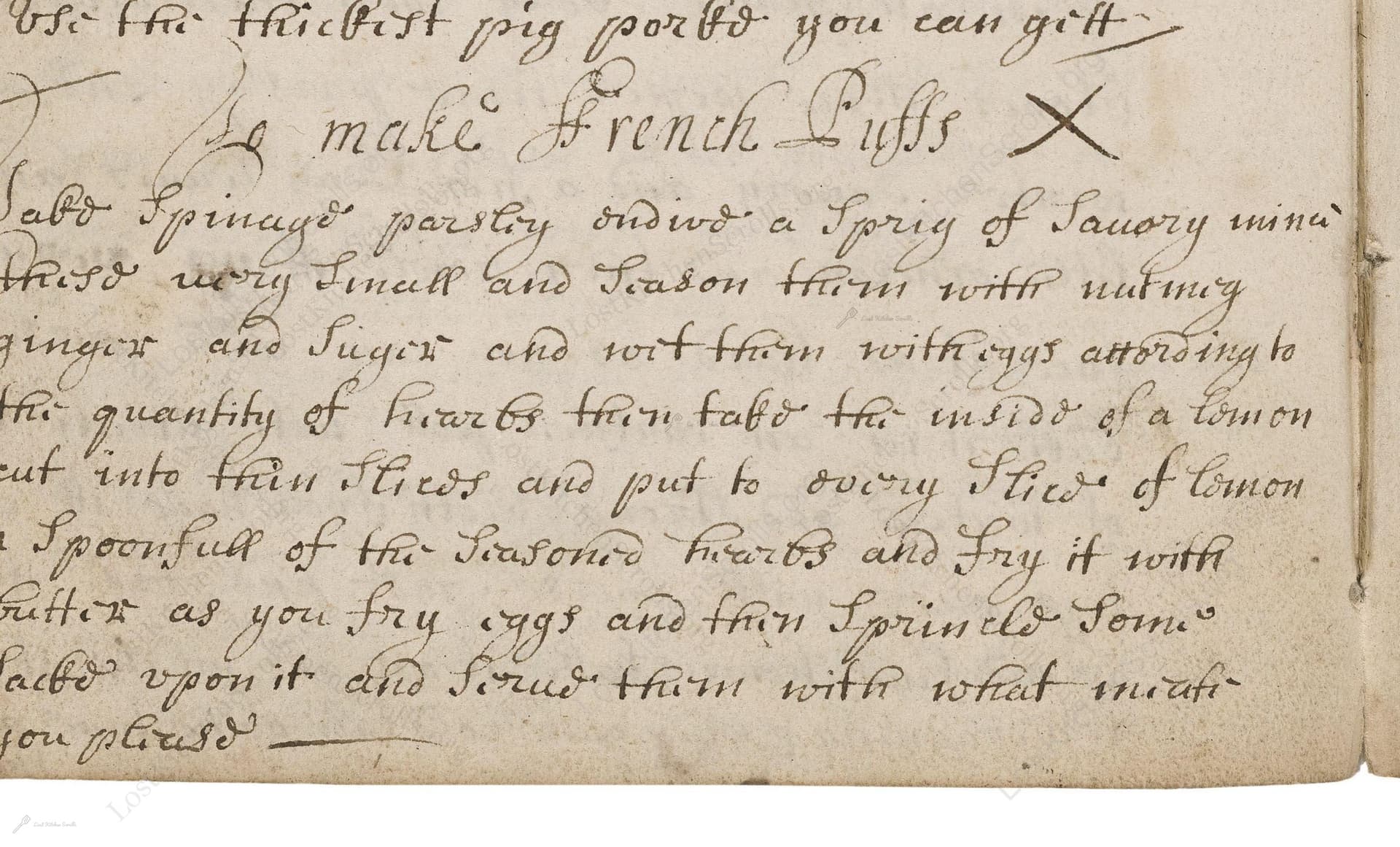To Make French Luffs
From the treasured pages of Cookery book of Ann Goodenough
Written by Ann Goodenough

To Make French Luffs
"Take Spinage parstor pindive a Sprig of Savory mint shred very Small and Season them with nutming ginger and Suger and sort them with eggs acording to the quantity of hearbs then take the inside of a lemon cut into thin Slices and put to every Slice of lemon a Spoonfull of the Seasoned hearbs and Fry it with butterr as you fry eggs and then Sprinkle some Salt upon it and Serve them with what inbate- you please -"
Note on the Original Text
The recipe is written in the typical style of the 18th-century English household manuscript: sparse on precise measurements and methods, relying on the cook's taste and experience. Spelling reflects the period's flexible conventions—'hearbs' for herbs, 'nutming' for nutmeg, and 'suger' for sugar—and grammatical shortcuts abound. Recipes typically list actions and ingredients in a continuous flow, making them a puzzle and adventure for the modern cook and historian. Terms like 'sort them with eggs' simply mean to combine or bind the greens with beaten eggs, while 'inbate' refers to accompaniment.

Title
Cookery book of Ann Goodenough (1738)
You can also click the book image above to peruse the original tome
Writer
Ann Goodenough
Era
1738
Publisher
Unknown
Background
A delightful journey into the kitchens of early 18th-century England, this collection captures the flair and flavors of its time with recipes crafted by the inventive Ann Goodenough. Expect a charming medley of hearty roasts, comforting pies, and time-honored confections, perfect for those wishing to dine as they did in Georgian days.
Kindly made available by
Folger Shakespeare Library
This recipe originates from the early-to-mid 18th century, attributed to Ann Goodenough, who flourished between 1700 and 1775. The recipe is a delightful example of how English cooks in the period were influenced by French culinary styles, particularly in their use of seasonal greens and aromatic herbs. At the time, recipes were generally handwritten in household manuscripts, intended for personal or family use rather than publication or professional kitchens. This context reflects both the resourcefulness and seasonal adaptability of home cooks and also hints at the growing interest in lighter, more refined dishes as international influences permeated British cooking.

The vegetables and herbs would have been shredded or chopped with a small kitchen knife, known as a 'pen-knife' at the time. Eggs would be beaten with a fork or a wooden whisk in a shallow bowl or pan. Cooking took place in a heavy iron skillet or shallow frying pan set over an open hearth fire, using butter for frying. Spoons and a simple pewter or wood plate for serving would complete the toolkit.
Prep Time
15 mins
Cook Time
10 mins
Servings
4
We've done our best to adapt this historical recipe for modern kitchens, but some details may still need refinement. We warmly welcome feedback from fellow cooks and culinary historians — your insights support the entire community!
Ingredients
- 3.5 oz fresh spinach
- 1.5 oz endive or flat-leaf parsley (as substitute)
- 0.04–0.07 oz fresh savory (or thyme, as substitute)
- 0.04–0.07 oz fresh mint
- 0.04 oz ground nutmeg
- 0.04 oz ground ginger
- 0.5 oz granulated sugar
- 2 medium eggs (3.5 oz)
- 1 lemon (flesh only, about 2 oz)
- 1 oz unsalted butter (for frying)
- 0.07 oz fine sea salt
Instructions
- To prepare French Luffs, begin by finely shredding about 3.5 oz of spinach and, if available, a small handful (1.5 oz) of endive or parsley.
- Add in a sprig each (roughly 0.04–0.07 oz each) of fresh savory and mint, chopped very small.
- Season your greens with a good pinch (about 0.04 oz) of freshly grated nutmeg, 0.04 oz ground ginger, and a tablespoon (0.5 oz) of sugar.
- Beat 2 medium eggs (about 3.5 oz total) and combine with the seasoned greens.
- Take one lemon and remove the flesh, discarding the peel and any seeds.
- Slice the lemon flesh into thin rounds.
- On each lemon slice, place a generous spoonful of the green egg mixture.
- Fry these little lemon-topped mounds gently in butter (about 1 oz for frying), turning once as you might with an egg.
- Once golden and cooked through, sprinkle lightly with salt (0.07 oz), and serve with your choice of accompaniment — perhaps warm bread or a fresh salad.
Estimated Calories
120 per serving
Cooking Estimates
You will spend about 15 minutes prepping the spinach, herbs, and lemon, and another 10 minutes frying the mounds. Each serving contains around 120 calories, and the recipe makes 4 servings.
As noted above, we have made our best effort to translate and adapt this historical recipe for modern kitchens, taking into account ingredients nowadays, cooking techniques, measurements, and so on. However, historical recipes often contain assumptions that require interpretation.
We'd love for anyone to help improve these adaptations. Community contributions are highly welcome. If you have suggestions, corrections, or cooking tips based on your experience with this recipe, please share them below.
Join the Discussion
Rate This Recipe
Dietary Preference
Main Ingredients
Culinary Technique
Occasions

Den Bockfisch In Einer Fleisch Suppen Zu Kochen
This recipe hails from a German manuscript cookbook compiled in 1696, a time whe...

Die Grieß Nudlen Zumachen
This recipe comes from a rather mysterious manuscript cookbook, penned anonymous...

Ein Boudain
This recipe comes from an anonymous German-language manuscript cookbook from 169...

Ein Gesaltzen Citroni
This recipe, dating from 1696, comes from an extensive anonymous German cookbook...
Browse our complete collection of time-honored recipes



